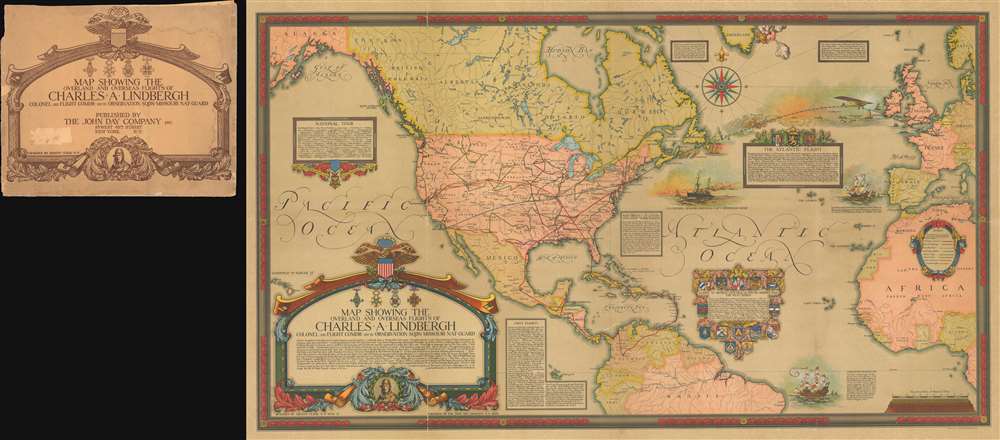This item has been sold, but you can get on the Waitlist to be notified if another example becomes available, or purchase a digital scan.
1928 Clegg Pictorial Map of the World Tracing the Flights of Charles Lindbergh
FlightsofLindbergh-clegg-1928
Title
1928 (dated) 27.5 x 47.25 in (69.85 x 120.015 cm) 1 : 17000000
Description
Lindbergh's Flights, Including the Historic Flight from New York to Paris
The first flight path begins in Americus, where he bought his first airplane, and is traced in a dark purple. The historic flight from New York to Paris is highlighted in sky blue and begins in San Diego, where Lindbergh picked up The Spirit of St. Louis, which he then flew across the country to Long Island. He departed Roosevelt Field, Long Island on May 20, 1927 and landed at Le Bourget Airport north of Paris thirty-three-and-a-half hours later on May 21. He returned to Washington, D.C. on June 11. His tour of the United States then followed, which lasted from July through late October 1927. Lindbergh then departed on his flight through Central America, northern South America, and the West Indies, which lasted from December 1927 through February 1928.Illustrations and Notations on the Map
Many illustrations present on the map refer to Lindbergh's exploits, including the depiction of The Spirit of St. Louis off the coast of Ireland and the vignette of the U.S.S. Memphis in the Atlantic. Text boxes provide a nearly day-by-day summary of his National Tour, the Flight through the Americas, and, of course, a detailed summary of The Atlantic Flight. The National Tour box is accompanied by an illustration of the Congressional Medal of Honor, which Lindbergh received from President Coolidge on March 21, 1928 by a special order of Congress. An index summarizing the different notations used to differentiate between the different flights is situated along the right border.Publication History and CensusThis map was designed and drawn by Ernest Clegg and published by The John Day Company in 1928. It is present in at least six institutional collections and is relatively scarce on the private market, with only a half dozen of examples of appearing on the market in recent years.
Cartographer
Ernest Clegg (1876 - December 7, 1954) was a British cartographer, graphic artist, and calligrapher. Born in the Birmingham suburbs in 1876, Clegg attended grammar school before gaining acceptance into the Birmingham School of Art. Clegg, who established himself as a specialist calligrapher during these years, was greatly influenced by the Victorian Arts and Crafts Movement and drew inspiration from illuminated manuscripts created during the medieval period. He joined the 7th Dragoon Guards at the outbreak of the Boer War in 1899, and took part in the British advance into the Orange River Colony and Transvaal as part of the 4th Cavalry Brigade in 1900-1901. Clegg was wounded in 1901 and sent back to Britain, and, following his recovery, he enlisted in the newly-formed South African Constabulary. He was posted to the South African Constabulary's sub-divisional headquarters in Harrismith, Transvaal, in 1902. After a year he was transferred to the offices of the District Engineer of Railways in Harrismith, a post he held for six months. Clegg returned to Birmingham in 1905 and went to work for Tiffany in New York as a jewelry designer in 1909. After the outbreak of World War I, Clegg returned to England and received a commission in the 7th (Service) Battalion, known as The Bedfordshire Regiment ("The Shiny 7th"). He served on the Western Front from early 1915 and was promoted to Major in early 1916. While visiting the HMS Revenge, Clegg became the only British Army officer to witness first-hand the pivotal naval Battle of Jutland. He returned to the Front and was badly wounded in a German artillery barrage in late June 1916, just days before the Battle of the Somme. He had recovered and returned to France by early 1917. By the end of the war, however, Clegg had served in several different Home postings, perhaps an indication of physical and psychological scars suffered during his time in France. After his return to the United States in 1919, Clegg became a well-known figure in the American and British veteran community in New York and soon began attracting clients for his work. He illustrated a limited edition of Canadian war poet John McCrae's In Flanders Fields in 1921 and by the mid-20s was gaining recognition for his decorative illustrations and cartographic work. Clegg created a pictorial map of Charles Lindbergh's historic flight across the Atlantic, and also issued maps for the Americas Cup in 1930, 1934, and 1937, which took place off Newport, Rhode Island. Clegg stayed in New York during most of World War II, but returned to England in late 1944, supposedly as a personal favor to the British Ambassador in Washington, Lord Halifax. He soon began working on a series of pictorial maps of English Counties meant to raise money for the Women's Land Army Benevolent Fund. For unknown reasons, possibly due to post-war shortages of paper, the full series of these maps was never published. Clegg's wife, the Australian actress Rita Holden Macdonnell, whom he married in 1911, passed away in 1949. He never fully recovered after her death, and died in a nursing home in Paignton on December 7, 1954. More by this mapmaker...

